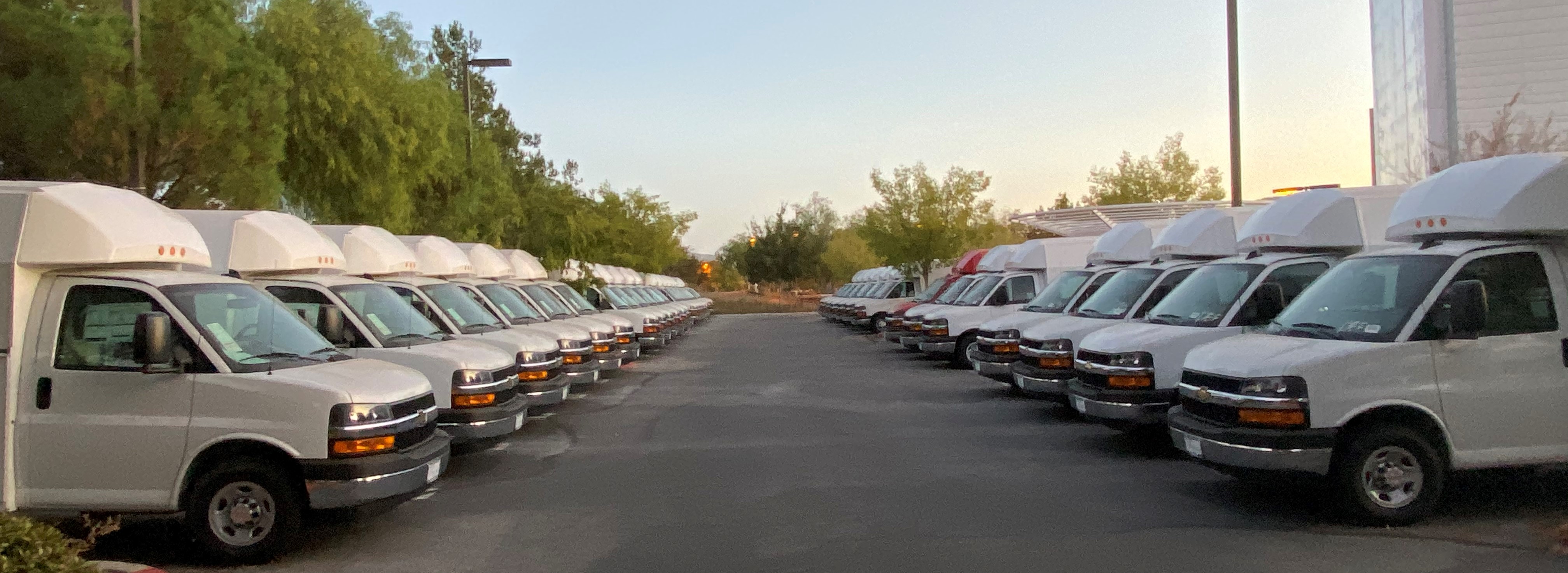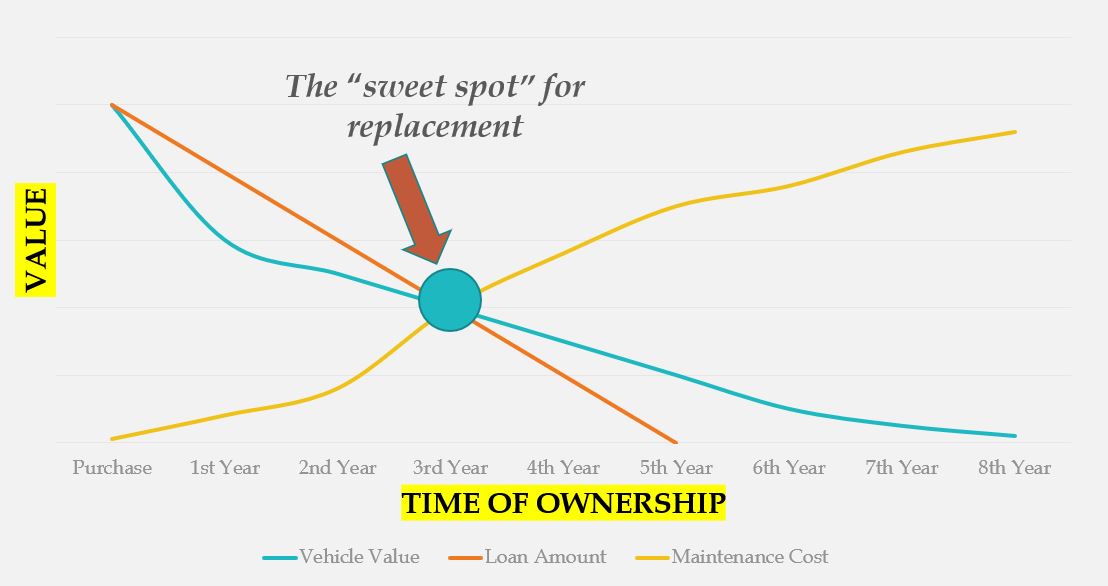
REPLACING YOUR FLEET Helping YOU Find the "Sweet Spot" for Your Fleet Vehicles
You can't know where you're going without knowing where you've been. You'll want to review and analyze your current fleet vehicles before shopping for new. Some driving questions for your analysis are:
- Do you have a set vehicle age or mileage for replacement or just drive it "until the wheels fall off"?
- When you trade in your vehicles do they have any equity left in them?
- Do you track your maintenance expenses? Individually or Aggregate?
- What do you do after you get the title of your fleet vehicles?
It seems like common sense to drive fleet vehicles right into the ground, if possible, before replacement. But for business managers and owners, vehicles are more than just transportation. Your fleet vehicles are the face and body of your company – both your image and your ability to perform. Put another way, your fleet vehicles have you dressed for the jobs you want, not the ones you already have.
It’s standard practice for most businesses to rely on their vehicles to produce revenue, through both the physical transportation of workers/equipment to existing jobs, as well as advertising and branding to help generate new contracts. . Whether you have a fleet of sports cars, a handful of vans, a few tractors, or a mix of different kinds, you need to know when it is time to stop throwing away money on repairs and simply replace the vehicle.
CURRENT TRENDING OF FLEET AGING
Over the past 20 years, the average age of fleet vehicles in America - before being sold/traded - has been on a steady incline. Innovations from cabin comfort to engine design have been booming, allowing these vehicles to retain their value for much longer. In 2000, the average age was 8 years old, 9.5 years in 2008, 11 years in 2015, and 13 years at the close of 2019.
While it can be fairly argued that these improvements can save you money by lengthening your buying cycles - and they do - the increased lifespan can also create its own pitfalls. Confidence in a strong, beautiful, long-lasting vehicle can lead to complacency and forgetfulness. Left unchecked, it can ultimately bring your business a net loss of time, money, new customers, etc. Re-evaluation is in order, and a new balance between profitability and longevity must be struck.
The most important thing to always keep on top of mind is the safety of the vehicle. Sharing the road with the public is something that should be taken seriously by all. It’s not enough to simply throw some new tires on a vehicle and call it safe. Your vehicles should undergo a full, comprehensive inspection at regular intervals, with frequency depending on the vehicle’s use. Obviously, the older and more often a vehicle is used, the more frequently you should schedule preventative maintenance and inspections.
Drivers are the first defense when it comes to vehicle safety. Each driver should do a brief inspection before every use of the vehicle and report any unusual occurrences or symptoms to those who oversee / manage the fleet. If the driver is concerned about the safety of a vehicle, it should be pulled off the road and inspected immediately.
IS IT WORTH IT?
Due to higher up-front cost, business managers and owners want to avoid new vehicle purchasing whenever possible. Sometimes, though, the best answer is to simply let that old vehicle go, and buy new. If repair expenses and downtime have (or will soon) cost the company more than the payment for a new vehicle, it might make more financial sense to stop repairing the vehicle and replace it.
The best way to determine whether repairs are costing more than a new vehicle is to look back at history and then forward focus toward the future. If you have fleet management software, it should be as easy as generating a repair report. If your records are maintained on paper or spreadsheets, the process may take even longer.
Evaluate your repair records and add up the expenses. Remember to factor in the cost of having the vehicle in the shop, rather than branding and promoting your company on the road and jobsite. Estimate future repairs, based on your history of maintenance costs for the type and age of vehicle. Finally, compare the cost of keeping that vehicle on the road to the expense of purchasing new. You may often find yourself calling it a “relief” rather than an “expense” to buy new.
There are other costs your old fleet vehicles may be incurring without you realizing it. If they are looking run-down and in poor repair, they might be portraying an image that is less than complimentary to your business. In fact, you may be losing customers to your competition if your fleet doesn’t contain shiny and new vehicles. Consider how many times you may have seen a poorly maintained older vehicle and thought to yourself “Hmm. Well that’s exactly who I won’t call”. First impressions can gain or lose money for your business.
BEST PRACTICES FOR OPTIMAL FLEET PERFORMANCE
Step 1
Create vehicle mileage & age timing thresholds
Step 2
Match your warranty period to time & mileage
Step 3
Structure loan term and payoff to coincide with usage
Step 4
Proactively order replacement units to minimize delays
"HOW LONG SHOULD I KEEP MY VEHICLES?"
The three main factors to consider when budgeting for the future are the “Vehicle Value”, “Loan Amount”, and “Maintenance Cost”. Vehicle Value drops immediately after purchasing, so it can take a few years for the loan to be paid down enough that the Vehicle Value is equal to or greater than the remaining loan balance. Also, remember that as the vehicle ages, the more - and more costly - repairs will be needed. Broadly, that sweet spot seems to be around 3 years of ownership before trading in for a new vehicle. Consider well the wear and tear on these new vehicles from being used in your particular business. Well maintained vehicles that stay in flatland suburbia will likely have a lower maintenance cost than, say, diesel dump trucks hauling boulders in heavily mountainous areas. These types of variables can have an effect on the best time to trade in and buy new.

"HOW WILL PROPER LOAN/VALUE/WARRANTY MATCHING HELP ME?"
There’s an old expression: Not every shoe is right for every person, even if it fits.
When purchasing a new vehicle, it is important to equally consider the cost of the vehicle loan, the value (to you, and in re-sale), and the warranty. When these three have been fully thought through between you and your Paradise Fleet Salesperson, you’ll know that you have gotten the right vehicle for the best price.
Your salesperson can help you reduce surprise disappointments in vehicle repairs by providing a warranty package that fits - without overextending - your usage needs and budget. As experts in the Fleet and Commercial industry, they can also help to ensure that you reap the best savings from increased qualifying tax incentives.
By spending only where necessary, you’ll be able to put the savings back into your business. Your new trucks will meet or exceed your customer’s expectations by always presenting a professional look, and minimizing delays due to unexpected equipment failure. While traveling to/from the jobsite, your new vehicles will brand your business effectively as professional and in-step with the current trends in business.
And finally, the happiness (and sanity) of your employees can be won or lost because of the vehicle they have to use. When your employees see that you have taken their concerns into consideration over cabin dimensions, media, and any other needed functionalities to do the work safely and comfortably, their productivity goes up.
"HOW DOES A HEALTHY FLEET CREATE HAPPY EMPLOYEES?"
Let’s face it -- most employees “live” in the vehicles you have supplied them with. Many become quite attached, and it’s great to see them giving special nicknames. Sometimes those nicknames are, shall we say, unrepeatable, and well-earned. As you are well aware, annoyances left unaddressed can quickly become problems; and those problems can become resentments. Other, similar businesses in the area may inadvertently lure away your workforce simply by having better, more comfortable vehicles.
Open lines of communication regarding your fleet vehicles (beyond safety notations) and encourage your employees’ feedback. A great way to keep your employees consistently producing at the highest levels is to provide incentives. Imagine how your productivity could increase after you announce a way for them to “earn” their name on the sides of their current work vehcile, or better still, the next new vehicle you buy. Never late, using less material than quoted, no moving violations, repeated willingness to work overtime -- there’s many ways to encourage higher levels of productivity. Maybe create a contest. If they have the chance to “move in” to that new vehicle you bought that has everything they need - and asked for - you’ll find many of them rededicating themselves to the highest levels of quality and professionalism. A win for everyone. You listen to them, WE listen to you.

